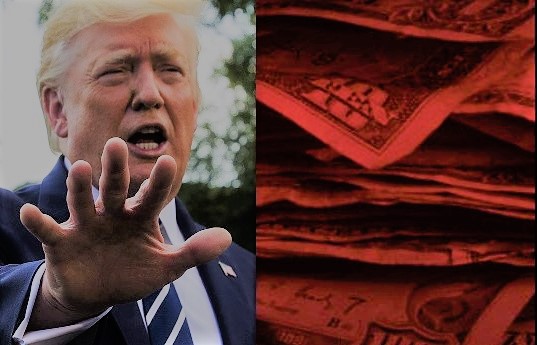President Trump and Congress are growing the economy on a mountain of red ink.
A combination of the 2017 tax cuts and a surge in new spending has pushed the deficit wider.
This year would mark the first time since 2012 that the deficit breached $1 trillion, a threshold that has alarmed some budget experts because deficits typically contract — not expand — during periods of sustained economic growth.
Overall, the CBO projected that the federal government will spend $4.6 trillion in the fiscal year that ends Sept. 30 and bring in $3.6 trillion in tax revenue.
And some of the costliest government programs are projected to experience expansions in the next decade.
Spending for Medicare, which provides health care for older Americans, will rise from $835 billion in 2020 to $1.7 trillion by 2030, while annual federal spending on Social Security will grow from roughly $1.1 trillion to $1.9 trillion over that span.
The CBO’s estimates assume that Congress will allow tax cuts for individuals passed in Republicans’ 2017 tax law to expire in 2025.
GOP lawmakers in Congress will at least try to extend most if not all of these provisions.
This year’s deficit would be an increase from 2019, when the government deficit grew to $984 billion.
The deficit in 2016, President Barack Obama’s last full year in office, was $585 billion.
CBO now projects that the deficit will be at least $1 trillion each year in perpetuity unless policymakers make changes.
The CBO also projected the economy would grow by 2.2 percent in 2020, which represents a healthy clip but falls short of the 3 percent target set by the Trump administration.
The projections were contained in the CBO’s annual budget and economic outlook.
With rising annual deficits, the total debt held by the government is also projected to grow dramatically, from about $18 trillion in 2020 to $31 trillion in 2030, according to the CBO’s projections.
The U.S. government must pay interest on this debt to keep borrowing money.
“The U.S. economy is doing well, with low unemployment and rising wages that have drawn people off the sidelines and back into the labor force,” Phillip L. Swagel, the CBO’s director, said in a statement. “But our projections also suggest that over the long-term, changes in fiscal policy must be made to address the budget situation.”
The deficit outlook appears slightly worse than it did just a year ago.
In 2019, bipartisan majorities in Congress approved new spending bills that added more than $500 billion to the deficit over the next decade.
The most expensive new policies were the permanent repeal of taxes created under Obama’s Affordable Care Act, including one on expensive health plans.
These actions would have done more to drive up the deficit had they not been mitigated by lower-than-expected interest rates, which allow the government to borrow money more cheaply than the CBO had originally anticipated.
The CBO projection also appears to cast doubt on recent statements by President Trump and other administration officials that the 2017 Republican tax cut is creating enough revenue through new economic growth that it will offset all near-term losses.
White House officials have defended the $1.5 trillion tax legislation, which slashed tax rates for businesses and many households.
Tax revenue has risen slowly since the tax cuts were passed, but many forecasters say the cuts led to a sizable drop-off in projected revenue collections.
Combined with an increase in spending, the deficit has ballooned, forcing the Treasury Department to borrow more money to cover the balance.
Trump, asked about the rising deficit following the tax cuts, told CNBC last year: “We’ve taken in more revenue substantially than we did when the taxes were high. Nobody can even believe it.”
Treasury Secretary Steven Mnuchin also expressed confidence the tax cut would not add to the nation’s debt, saying: “We’ve tracked the numbers, and we’re right on track.”
Trump has told aides he will look for big spending cuts in his second term, a position echoed by Mnuchin, who said government spending must be slowed down.
Trump aides have also previewed a potential second round of tax cuts.
The CBO report shows that tax collections are weaker than they would be without the 2017 Republican tax law, which permanently locked in lower rates for many corporations while creating temporary reductions for households.
Tax revenue remained roughly flat the first year the law was in effect, despite economic growth of nearly 3 percent. It rose slightly in 2019 but not enough to compensate for flatlining the year before.
Asked about Mnuchin’s remarks on Tuesday, Swagel pointed to CBO’s April 2018 analysis finding the GOP tax law would increase the deficit by $1.9 trillion over 10 years.
That number accounts for the impact of faster economic growth due to the tax law. Swagel served as a Treasury official in George W. Bush’s administration and worked at the American Enterprise Institute, a conservative think-tank.
In January 2017, before the tax law, the CBO projected corporate tax revenue would represent 1.8 percent of gross domestic product.
Now, they are expected to represent only 1.1 percent of GDP.
Many Republicans in recent years have abandoned the calls to slash spending in part because Trump has supported big increases in the budget.
During the Obama administration, many Republicans insisted on spending cuts as a way to shrink the deficit.
About half of the current deficit can be attributed to spending increases and tax cuts put in place by Congress since 2015, according to the nonpartisan Committee for a Responsible Federal Budget.
“This is an important warning light,” Marc Goldwein, a budget expert with the group, said of the CBO’s report. “We know deficits as a share of GDP have never been this high when the economy is this strong.”
Trump vowed to eliminate the debt in 8 years

